Timeline of the Tang dynasty
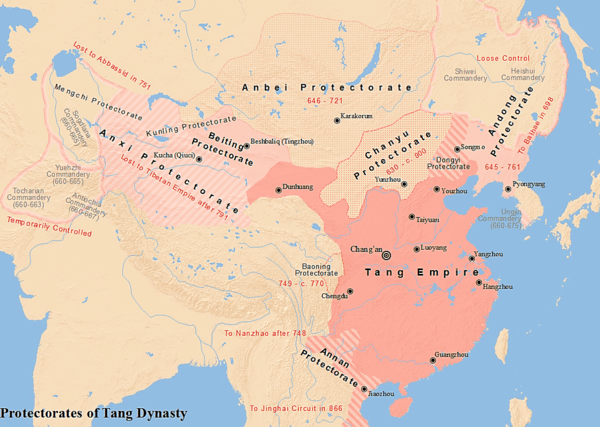
Map of the Tang dynasty
This is a timeline of the Tang dynasty, which covers a period of roughly 289 years, from 618, when the dynasty was founded, to 907, when the last Tang emperor was deposed by the warlord Zhu Wen, who established the Later Liang dynasty, inaugurating the period of Five Dynasties and Ten Kingdoms. Information on areas and events relevant to the Tang dynasty such as the Wu interregnum, when Wu Zetian established her own Zhou dynasty, and other realms such as the Sui dynasty, Tibetan Empire, Three Kingdoms of Korea, Nanzhao, Japan and steppe nomads are also included where necessary.
7th Century
610s
| Year | Date | Event |
|---|---|---|
| 617 | Shibi Khan of the Eastern Turkic Khaganate aids Li Yuan in his rebellion against the Sui dynasty[1] | |
| 618 | 11 April | Emperor Yang of Sui is killed by strangulation in a coup led by his general Yuwen Huaji in Jiangdu[2] |
| 12 June | Li Yuan (Emperor Gaozu of Tang - note that Tang emperor naming convention uses the posthumous Temple Name) deposes Yang You and founds the Tang dynasty; so ends the Sui dynasty[2] | |
| 29 November | Battle of Qianshuiyuan: Li Shimin defeats pretender Xue Rengao and his short lived state of Qin | |
| 619 | Wang Bo (王薄) and Du Fuwei surrender to Tang[3][4] | |
| Some of the most powerful independent forces include Wang Shichong in Luoyang, Liu Wuzhou in north Shanxi, Dou Jiande in Hebei, and Shen Faxing in the south[2] | ||
| Yuwen Huaji is killed by Dou Jiande[2] |
620s
| Year | Date | Event |
|---|---|---|
| 620 | Li Shimin defeats Liu Wuzhou[2] | |
| 621 | 28 May | Battle of Hulao: Tang forces defeat the warlord Dou Jiande and he is captured by Li Shimin[2] |
| Tang forces defeat Wang Shichong and take Luoyang[2] | ||
| Dou Jiande's general Liu Heita rebels[2] | ||
| 622 | Rebel Li Zitong tries to flee from Chang'an but is arrested and executed[5] | |
| Illig Qaghan of the Eastern Turkic Khaganate attacks Tang[6] | ||
| 623 | Tuyuhun invasion of Gansu: Chai Shao defeats a Tuyuhun invasion of Gansu[7] | |
| Li Jiancheng defeats Liu Heita; Liu Heita is captured and killed[2] | ||
| Fu Gongshi declares himself emperor in Danyang, Jiangsu (Nanjing)[2] | ||
| 624 | Fu Gongshi is killed; Tang forces conquer the south[2] | |
| Zu Yong Diao tax system is implemented[2] | ||
| Illig Qaghan of the Eastern Turkic Khaganate and his nephew Tölis Qaghan (Ashina Shibobi) invade the Tang dynasty but Li Shimin contacts Tölis and persuades him not to attack, forcing the invasion to a halt[8][2] | ||
| 625 | Eastern Turkic Khaganate launches repeated raids in northern frontier areas; some raids reach as far south as Shanxi; largest one was directed by Illig Qaghan against Shuozhou (in north Shanxi) but is repulsed[2] | |
| 626 | 2 July | Xuanwu Gate Incident: Li Shimin kills his brothers the crown prince Li Jiancheng and Li Yuanji at Chang'an[2] |
| 4 September | Emperor Gaozu of Tang is forced into retirement and Li Shimin becomes emperor (Taizong)[2] | |
| Autumn | Illig Qaghan of the Eastern Turkic Khaganate raids to within a few miles of Chang'an and withdraws after Emperor Taizong of Tang agrees to a payment of tribute.[2] | |
| 627 | A large number of prefectures and counties are combined or abolished; the Ten Circuits are introduced[2] | |
| Tang dynasty and Uyghur forces engage in battle with the Turks and Tibetans[9][10] | ||
| 628 | 3 June | Rebel Liang Shidu dies from assassination[2] |
| 629 | Buddhist monk Xuanzang sets off for the west[2] |
630s
| Year | Date | Event |
|---|---|---|
| 630 | Tang campaign against the Eastern Turks: Illig Qaghan of the Eastern Turkic Khaganate is defeated by Li Jing of the Tang dynasty and captured by Li Shiji but released; the Eastern Turkic Khaganate becomes a vassal of Tang; Emperor Taizong of Tang becomes heavenly qaghan[2][11] | |
| Japanese missions to Tang China: Japan sends its first mission to the Tang dynasty[12] | ||
| 631 | Gao Biaoren (高表仁) accompanies Japanese embassy back to Japan[13] | |
| 632 | Khotan (Yutian) and Kashgar (Shule) submit to the Tang dynasty as vassals[14] | |
| Qibi Heli of the Tiele bring more than 1,000 households to Tang[15] | ||
| 634 | Yong'an Palace (永安宮) (Daming Palace) is completed[16] | |
| Songtsen Gampo of the Tibetan Empire sends an embassy to the Tang[17] | ||
| 635 | Emperor Taizong's campaign against Tuyuhun: Emperor Taizong of Tang launches a campaign against Tuyuhun, a Xianbei empire to the west, and annexes the area[18] | |
| Yarkand (Shache) submits to the Tang dynasty.[14] | ||
| Yong'an Palace renamed Daming Palace[16] | ||
| 636 | The fubing system is revised to comprise 634 intrepid garrisons (zhechong fu 折衝府)[12] | |
| 638 | Gar Tongtsen Yulsung of the Tibetan Empire arrives in Tang to ask for a princess bride[19] | |
| Tibetan attack on Songzhou: The Tibetan Empire attacks the city of Songzhou, now modern Songpan, in Sichuan[20] | ||
| 639 | Census estimates a total population of 50 million residing within Tang administrated territory[21][22] |
640s
| Year | Date | Event |
|---|---|---|
| 640 | Tang campaign against Karakhoja: Hou Junji conquers Karakhoja and annexes Gaochang (Turpan, Xinjiang); the Protectorate General to Pacify the West is created[12][23] | |
| Gar Tongtsen Yulsung of the Tibetan Empire arrives in Tang with tribute and successfully requests for a princess bride[24] | ||
| 641 | Princess Wencheng, an imperial sororal kin of the Tang dynasty, arrives in Tibet as Songtsen Gampo's bride[12] | |
| 643 | Crown Prince Li Chengqian is deposed[12] | |
| 644 | Emperor Taizong of Tang starts preparations for a campaign against Goguryeo[12] | |
| Tang campaigns against Karasahr: Tang general Guo Xiaoke attacks Karasahr and achieves military victory but Karasahr remains a vassal of the Western Turkic Khaganate[25] | ||
| Aksu (Gumo) submits to Tang [25] | ||
| 645 | First campaign in the Goguryeo–Tang War: Emperor Taizong of Tang leads an invasion of Goguryeo in person but withdraws after failure to conquer Anshi (northeast of Yingkou, Liaoning)[12] | |
| Xuanzang returns from India[12] | ||
| 646 | Emperor Taizong's campaign against Xueyantuo: Tang forces defeat Xueyantuo in battle and their khan surrenders[26] | |
| 647 | Li Shiji leads another campaign against Goguryeo, but does not succeed[12] | |
| 648 | Emperor Taizong of Tang launches one more campaign against Goguryeo unsuccessfully[12] | |
| Tang campaign against Kucha: Tang general Ashina She'er conques Kucha (Qiuci)[23] | ||
| Songtsen Gampo of the Tibetan Empire attacks Arjuna, usurper of Harsha of Mithila, for accosting the Tang ambassador Wang Xuance[27][12] | ||
| Khitans submit to Tang as vassals[28] | ||
| 649 | 10 July | Emperor Taizong of Tang sucumbs to illness, possibly from the pills he took from his alchemists, and dies, his son Li Zhi succeeds him and becomes Emperor Gaozong of Tang[12] |
| The campaign against Goguryeo is called off[12] |
650s
| Year | Date | Event |
|---|---|---|
| 650 | Earliest known extant piece of printed text appears in Chang'an: a fragment of a Buddhist dhāraṇī scroll written in Sanskrit, known as the Great spell of unsullied pure light (Wugou jingguang da tuoluoni jing 無垢淨光大陀羅尼經)[29] | |
| 653 | A woman claims the title of emperor and rises in rebellion, causing widespread disruption for a few weeks before she is defeated and dies[30] | |
| 655 | Wu Zetian is set up as empress[12] | |
| 656 | Cheng Yaojin defeats the Karluk and Turgesh forces of the Western Turkic Khaganate[12] | |
| 657 | Battle of Irtysh River: Ashina Helu of the Western Turkic Khaganate is defeated by Su Dingfang of the Tang dynasty[31] | |
| 658 | Conquest of the Western Turks: Ashina Helu of the Western Turkic Khaganate is defeated by Su Dingfang of the Tang dynasty and lives out the rest of his days in Chang'an; the Western Turkic Khaganate is annexed by Tang[32] | |
| Luoyang becomes the Eastern Capital[12] | ||
| 659 | Evidence of a dental amalgam appears in the medical text Hsin Hsiu Pen Tsao written by Su Kung, manufactured from tin and silver.[33] |
660s
| Year | Date | Event |
|---|---|---|
| 660 | Su Dingfang defeats Baekje[12] | |
| Tibetan Empire and their Turkic allies attack Shule[34] | ||
| Tang attacks the Khitans and captures their leader Abugu, sending him back to Luoyang[35] | ||
| Emperor Gaozong of Tang begins suffering from severe headaches as well as loss of vision and yields decision making power to Wu Zetian[12] | ||
| 661 | Su Dingfang lays siege to Pyongyang[12] | |
| Peroz III of the Sasanian Empire requests military aid from Tang against the Arab invasion of Persia[36] | ||
| 662 | Tang troops lift siege of Pyongyang due to lack of food supplies[37] | |
| Liu Rengui inflicts a fatal blow on Baekje[37] | ||
| The Daming Palace is rebuilt[16] | ||
| 663 | Battle of Baekgang: Liu Rengui and others vanquish Baekje, having defeated a combined Baekje and Yamato fleet[37] | |
| Tibetan Empire attacks Yutian but are repelled[38] | ||
| The Daming Palace is completed[39] | ||
| 664 | Liu Rengui sends a memorial to the emperor reporting low morale of troops in Korea[40] | |
| Emperor Gaozong of Tang makes a failed attempt to depose Wu Zetian[37] | ||
| 665 | Wu Zetian becomes the de facto ruler[37] | |
| Tibetan Empire and Turkic allies attack Yutian[34] | ||
| 667 | Xue Rengui achieves a decisive victory against Goguryeo[37] | |
| 668 | Li Shiji sacks Pyongyang and conquers Goguryeo;[37] the Protectorate General to Pacify the East is established[41] | |
| 669 | General Li Shiji dies[37] |
670s
| Year | Date | Event |
|---|---|---|
| 670 | Battle of Dafei River: Tibetan Empire destroys Xue Rengui's allegedly 100,000 strong army, captures Qiuci, and attacks Gumo[37][42] | |
| Peroz III arrives at the Tang court[36] | ||
| 673 | Tang captures Qiuci[23][34] | |
| Tang consolidates control over the Wudoulu Turks living in the area that came to be known as Dzungaria[43] | ||
| 675 | Tang defeats Silla in Gyeonggi[41] | |
| 676 | Tibetan Empire attacks Die, Fu, and Jing prefectures. Fengtian and Wugong are sacked.[44] | |
| The Protectorate General to Pacify the East relocates to Liaoyang[45][46] | ||
| 677 | Tibetan Empire captures Qiuci[23][34] | |
| Ashina Duzhi, previously a Tang general tasked with controlling the Wuduolu Turks, rebels and declares himself Onoq Khagan, ruler of all Turks.[44] | ||
| The Protectorate General to Pacify the East relocates to Xincheng, in modern Fushun, Liaoning[45][46] | ||
| 678 | Tibetan Empire defeats a Tang army in the Qinghai region[42] | |
| Pei Xingjian (裴行儉) attempts to escort Peroz III back to Persia and makes it as far as Suiye (Tokmok, Kyrgyzstan)[36] | ||
| 679 | Pei Xingjian escorts Peroz's son Narsieh to Suiye, and Narsieh spends 20 years in Tukhara[44] | |
| Pei Xingjian defeats a rebellion by Onoq Qaghan (Ashina Fuyan Duzhi 阿史那匐延都支) and Li Zhefu (李遮匐)[36] | ||
| Pei Xingjiang defeats the Tibetans and re-establishes control over the Tarim oasis states[23][34] | ||
| Ashide Wenfu and Ashide Fengzhi of the Chanyu Protectorate make Ashina Nishufu a Khagan and revolt against Tang dynasty.[47] |
680s
| Year | Date | Event |
|---|---|---|
| 680 | Pei Xingjian defeats Ashina Nishufu and Ashina Nishufu is killed by his men.[47] | |
| Ashide Wenfu makes Ashina Funian a Khagan and revolts against Tang dynasty.[47] | ||
| Pei Xingjian convinces Ashina Funian to surrender; Funian is executed in Chang'an[37] | ||
| Tibetan Empire expands aggressively into Xiyu (Western Regions)[37] and captures of the fortress of Anrong in Sichuan[42] | ||
| 681 | Ilterish Qaghan revolts with the remnants of Ashina Funian's men.[48] | |
| Tibetan Empire invades the Qinghai region but is defeated by a Tang army[49] | ||
| 682 | Ilterish Qaghan establishes the Second Turkic Khaganate[37][50] and attacks Tang[51] | |
| 683 | 27 December | Emperor Gaozong of Tang succumbs to illness and dies, his son Li Xian succeeds him and becomes Emperor Zhongzong of Tang[37] |
| Ilterish Qaghan of the Second Turkic Khaganate attacks Tang[51] | ||
| 684 | 26 February | Wu Zetian deposes Emperor Zhongzong of Tang, replaces him with Emperor Ruizong of Tang[37] |
| Xu Jingye rebels in Yangzhou and fails[37] | ||
| Ilterish Qaghan of the Second Turkic Khaganate attacks Tang[51] | ||
| 685 | Ilterish Qaghan of the Second Turkic Khaganate attacks Tang[51] | |
| 686 | Tang troops withdraw from the Four Garrisons of Anxi after elements within the court argue for the decrease of military expenditures[52][23][34] | |
| 687 | Ilterish Qaghan of the Second Turkic Khaganate attacks Tang[51] | |
| Lý Tự Tiên and Đinh Kiến revolt at Đại La in response to a raise in harvest tax[53] | ||
| 688 | Wu Zetian carries out killing of Tang princes and princesses[37] | |
| 689 | The ritual structure Mingtang (Hall of Brightness) is set up in Luoyang[37] |
690s
| Year | Date | Event |
|---|---|---|
| 690 | 16 October | Wu Zetian starts the first official Palace Examination (dianshi 殿試)[37] |
| Wu Zetian declares herself emperor of the Zhou dynasty in Luoyang[37] | ||
| Tibetan Empire defeats a Tang army at Issyk-Kul[54] | ||
| 692 | Tang forces reconquer the Four Garrisons of Anxi from Tibetan Empire[25] | |
| 693 | Qapaghan Qaghan of the Second Turkic Khaganate conducts raids against the Tang dynasty[55] | |
| Commoners and gentry from non-elite backgrounds are permitted to take the imperial examinations. | ||
| 694 | Tibetan Empire attacks the Stone City (Charklik).[56] | |
| Qapaghan Qaghan of the Second Turkic Khaganate conducts raids against Tang[57] | ||
| 696 | Qapaghan Qaghan of the Second Turkic Khaganate defeats the Khitans to the east and raids Tang[55] | |
| Li Jinzhong (Mushang Khan) of the Khitans along with his brother-in-law Sun Wanrong revolt against Tang hegemony and attack Hebei; Li dies soon after and Sun succeeds him[58] | ||
| Tibetan Empire defeats a Tang army at Tao Prefecture and attacks Liang Prefecture[56] | ||
| 697 | The Zhang brothers Yizhi and Changzong are admitted into the palace to attend on Wu Zetian[37] | |
| Qapaghan Qaghan of the Second Turkic Khaganate defeats the Khitans and conducts raids against Tang[57] | ||
| 698 | Battle of Tianmenling: Dae Jo-yeong's Goguryeo remnants and Mohe people defeat Tang forces[59] | |
| Dae Jo-yeong establishes the state of Jin (震) in northern Korea, later renamed Balhae (渤海) in 712[59] | ||
| Qapaghan Qaghan of the Second Turkic Khaganate conducts raids against the Tang dynasty[55] | ||
| 699 | Go Deokmu rebels and creates Lesser Goguryeo; the Protectorate Genereal to Pacify the East is moved to Pingzhou, in modern Lulong County[58][46] |
8th Century
700s
| Year | Date | Event |
|---|---|---|
| 700 | Tridu Songtsen of the Tibetan Empire attacks He and Liang prefectures[60] | |
| 701 | Tridu Songtsen of the Tibetan Empire allies with Turks and attacks Liang, Song, and Tao prefectures[60] | |
| 702 | Qapaghan Qaghan of the Second Turkic Khaganate conducts raids against the Tang dynasty[55] | |
| Tibetan Empire attacks Mao Prefecture[61] | ||
| Military examinations are introduced to recruit new officers as a response to the breakdown of the fubing system.[62] | ||
| 705 | 23 February | Zhang Jianzhi kills the Zhang brothers in a coup and restores the Tang with Emperor Zhongzong of Tang as emperor; Wu Zetian dies from illness not long after[37] |
| The earliest known printed text created specifically for reading, the Lotus Sutra, is dated to this year[29] | ||
| 706 | Qapaghan Qaghan of the Second Turkic Khaganate conducts raids against the Tang dynasty[55] | |
| 707 | Crown Prince Li Chongjun starts a coup in which he kills Wu Sansi and assaults the palace; the coup fails and he is killed by his own soldiers while fleeing[63] | |
| Qapaghan Qaghan of the Second Turkic Khaganate conducts raids against Tang[64] | ||
| 708 | Turgesh attacked Qiuci[65] | |
| Peroz III arrives back at the Tang court[36] |
710s
| Year | Date | Event |
|---|---|---|
| 710 | 3 July | Emperor Zhongzong of Tang is poisoned to death by Empress Wei (his second wife), and Princess Anle, their daughter; Emperor Zhongzong of Tang's youngest son Emperor Shang of Tang succeeds the throne[63] |
| 25 July | Emperor Gaozong of Tang's daughter Princess Taiping instigates a coup and grandson Li Longji kills Empress Wei; Emperor Shang of Tang is replaced by Emperor Ruizong of Tang[63] | |
| Princess Jincheng, a great granddaughter of Emperor Gaozong of Tang, is sent to Tibet as a bride; the Tibetans are granted Jiuqu (九曲), the land north of the Yellow River in Gansu by Emperor Ruizong of Tang[66] | ||
| Zhang Xuanbiao of the Tang dynasty invades northeastern Tibet[67] | ||
| 711 | The post of jiedushi is created | |
| 712 | 8 September | Emperor Ruizong of Tang abdicates in favor of his son Li Longji (Emperor Xuanzong of Tang)[63] |
| Jin renames itself Balhae[68] | ||
| 713 | Princess Taiping is ordered to kill herself after her failed attempt to unseat Emperor Xuanzong of Tang[63] | |
| Construction begins on the Leshan Giant Buddha[69] | ||
| 714 | Tibetan Empire attacks Lintao and Weiyuan as well as Lan and Wei prefectures, but ultimately suffer a major defeat and are repelled[70] | |
| 715 | Zhang Xiaosong (張孝嵩) assists Fergana (Bahanna 拔汗那) in repulsing attacks by Tibetans and Arabs[63] | |
| Tibetan Empire attacks the Beiting Protectorate and Song Prefecture[71] | ||
| 716 | Khitans break alliance with the Turks and ally with Tang[72] | |
| 717 | Battle of Aksu (717): Tibetan Empire attacks Gumo and the Stone City.[73][74] | |
| 719 | Turgesh captures Suiye[65] |
720s
| Year | Date | Event |
|---|---|---|
| 720 | Bilge Khagan of the Second Turkic Khaganate invades the Tang dynasty and extracts tribute[48] | |
| The governor-general of Ying Prefecture sends 500 Tang soldiers to interfere in Khitan conflicts but is defeated[75] | ||
| Tibetan Empire seizes the Stone City[76] | ||
| Tang bestows titles on the kings of Oddiyana, Khuttal, and Chitral[77] | ||
| 722 | Tang assists Lesser Bolü (小勃律, a city state centering modern Gilgit, Pakistan, in Kashmir) in repulsing advancing Tibetan troops[63] | |
| Mai Thúc Loan rebels in Annam and is defeated[78] | ||
| 723 | Princess Jincheng writes to Lalitaditya Muktapida of the Karkoṭa Empire asking for asylum. In response he contacts Zabulistan and forms an alliance against the Tibetan Empire.[79] | |
| 724 | Wang Junchuo launches an attack on the Tibetan Empire and scores a victory[76] | |
| 725 | The king of Khotan rebels but is immediately replaced with a Tang puppet by the Anxi Protectorate[76] | |
| 726 | Turgesh attacks Qiuci[65] | |
| Stag sgra khon lod of the Tibetan Empire attacks Gan Prefecture but most of their forces die in a snowstorm and the rest are mopped up by Wang Junchuo[80] | ||
| 727 | Stag sgra khon lod and Cog ro Manporje of the Tibetan Empire and the Turgesh attack Qiuci[65] and Gua Prefecture[63][80] | |
| 728 | Tibetan Empire attacks Qiuci[65] | |
| 729 | Zhang Shougui (張守珪) inflicts a major defeat on the Tibetan Empire at Xining[81][63] |
730s
| Year | Date | Event |
|---|---|---|
| 730 | Ketuyu of the Khitans attacks Tang[82] | |
| 732 | Tang forces inflict heavy casualties on the Khitans and Kumo Xi[83] | |
| 733 | A Tang-Kumo Xi army attacks a Turk-Khitan army[84] | |
| 734 | Tang and Tibetan Empire demarcate their territory Chiling Mountain with a boundary tablet[85] | |
| Zhang Shougui defeats Khitan forces in Youzhou (Hebei)[63] | ||
| 735 | Turgesh attack Ting Prefecture.[73] | |
| 736 | An Lushan attacks the Khitans but is defeated[86] | |
| 737 | Piluoge (皮羅閣) unites the six zhaos (kingdoms) with Tang support[87] | |
| Hexi jiedushi Cui Xiyi makes a covenant with the Tibetan general in Koko-nor, Yilishu, to relax border defenses so their soldiers can engage in agriculture and animal husbandry. A white dog is sacrificed to seal the covenant.[88] | ||
| 738 | Tang captures and loses Anrong to the Tibetan Empire[89] | |
| 739 | Tang scores a major victory against the Tibetan Empire at Shan Prefecture[89] | |
| The Tang Institutions of Six Administrative Divisions (Tang Liudian 唐六典) is completed[63] |
740s
| Year | Date | Event |
|---|---|---|
| 740 | Tang captures Anrong from the Tibetan Empire[90][91] | |
| An Lushan attacks the Khitans[75] | ||
| 741 | Tibetan Empire attacks Tang in the Qinghai region but is repelled; the Tibetans sack the Stone City on their way back[92] | |
| 742 | Huangfu Weiming of Longyou and Wang Chui of Hexi invade northeastern Tibet and kill several thousand Tibetans[93] | |
| 743 | Tang recovers the Jiuqu (九曲) area from the Tibetan Empire[92] | |
| The Protectorate General to Pacify the East is relocated to the Old City of Liaoxi, possibly Ying Prefecture (modern Chaoyang, Liaoning.[58][46] | ||
| 745 | Tibetan Empire defeats a Tang army at the Stone City[92] | |
| Two Khitan tribes revolt and are defeated by An Lushan[75] | ||
| 747 | Gao Xianzhi marches across the Pamirs with 10,000 men and conquers Little Balur (Gilgit), a client state of the Tibetan Empire[90] | |
| 748 | Tang constructs a fortress on an island on the Qinghai Lake, pacifying the northern Qinghai region[92] | |
| Tang recaptures Suyab and destroys it[65] | ||
| 749 | The fubing system is all but abolished[94] | |
| Longyou defense command under Geshu Han attacks Tibetan Empire and retakes the Stone City but suffers heavy casualties[94][90] |
750s
| Year | Date | Event |
|---|---|---|
| 750 | Tang defeats the Turgesh-Chach and executes the king of Chach[65][95] | |
| Chinese cultural dominance in Liaoning disappears and is replaced by Khitan culture[96] | ||
| 751 | Battle of Talas: Tang forces are defeated by Arabs[94] | |
| Xianyu Zhongtong attacks Nanzhao with an army of 80,000 but is utterly defeated, losing three quarters of his original force[97] | ||
| 752 | An Lushan attacks the Khitans[98] | |
| 753 | Geshu Han ejects the Tibetans from the "Nine Bends" region on the upper course of the Yellow River[90] | |
| 754 | Yang Guozhong invades Nanzhao but fails to engage with the enemy until supplies ran out, at which time they were attacked and routed[97] | |
| Monk Jianzhen arrives in Japan and establishes the Risshū (Buddhism) sect in Nara[94] | ||
| 755 | An Lushan Rebellion: An Lushan rebels and declares himself emperor of Yan[94] | |
| 756 | spring | Battle of Yongqiu: Yan forces retreat from their siege of a Tang fortress[94] |
| 12 August | Emperor Xuanzong of Tang flees Chang'an. On his way to Sichuan, he is forced to order the death of his favorite consort Yang Guifei and abdicates in favor of Emperor Suzong of Tang[94] | |
| The Taoist Mao Kua reports in his Pinglongren (Recognition of the Recumbent Dragon) that by heating saltpeter, the yin of the air can be obtained, which combines with sulphur, carbon, and metals other than gold.[99] | ||
| 757 | An Lushan is killed by his son An Qingxu[94] | |
| Battle of Suiyang: Yan forces emerge victorious with great losses[100] | ||
| Tang counterattack under Guo Ziyi and Uyghur allies evict the Yan from Chang'an and Luoyang[101] | ||
| An Qingxu flees across the Yellow River to southern Hebei[101] | ||
| Tibetan Empire conquers Shan Prefecture[102] | ||
| 758 | Princess Ningguo, second daughter of Emperor Suzong of Tang, marries Bayanchur Khan of the Uyghur Khaganate[103][104] | |
| 759 | An Qingxu is killed by rebel Shi Siming[94] | |
| Shi Siming occupies Luoyang[105] | ||
| Jianzhen founds the Tōshōdai-ji in Nara, Japan[106] |
760s
| Year | Date | Event |
|---|---|---|
| 760 | Yangzhou massacre: Troops under Tian Shengong slaughter Arab and Persian merchants in Yangzhou | |
| Lu Yu (730s-circa 804) composes The Classic of Tea[107] | ||
| 761 | Shi Siming is killed by his son Shi Chaoyi[94] | |
| The Protectorate General to Pacify the East is abolished[58][46] | ||
| 762 | 3 May | Emperor Xuanzong of Tang dies from depression[94] |
| 16 May | Emperor Suzong of Tang dies of a heart attack[94] | |
| 18 May | Emperor Daizong of Tang ascends the throne[94] | |
| Tang army and Uyghur allies defeat Shi Chaoyi's army and retake Luoyang; both Tang soldiers and Uyghurs loot the city[108] | ||
| 763 | An Lushan Rebellion: Shi Chaoyi commits suicide and the An Lushan Rebellion ends[94] | |
| Tibetan Empire invades the Tang dynasty with an army of 100 000 and briefly occupies Chang'an for 15 days before retreating[94][109] | ||
| Tibetan Empire conquers Yanqi[110] | ||
| 764 | 5 January | Yan Wu (嚴武) is made jiedushi of Jiannan[111] |
| Fall | Tibetan Empire invades the Tang dynasty with a 70 000 strong army and takes Liang Prefecture[112] but is repulsed by Yan Wu in Jiannan[113] | |
| 765 | Tibetan Empire invades the Tang dynasty with 30 000 troops and Uyghur allies, advancing as far as Fengtian twice but are repulsed by Guo Ziyi, who convinced the Uyghurs to switch sides[94] | |
| 766 | Tibetan Empire conquers Gan and Su prefectures.[112] | |
| 767 | Sea people invade Annam and are defeated[78] |
770s
| Year | Date | Event |
|---|---|---|
| 776 | Tibetan Empire conquers Gua Prefecture.[112] | |
| 779 | 10 June | Emperor Daizong of Tang dies from illness; Emperor Dezong of Tang succeeds him[94] |
780s
| Year | Date | Event |
|---|---|---|
| 780 | A group of Uyghurs and Sogdians are killed while leaving Chang'an with tribute. The Tang agree to 1,800,000 strings of cash in compensation.[114] | |
| The dual tax system is implemented[94] | ||
| 781 | Tibetan Empire conquers Yi Prefecture.[110][112] | |
| Guo Ziyi dies[94] | ||
| 782 | Wang Wujun of Chengde and Zhu Tao of Lulong join Tian Yue of Weibo in rebellion against Tang[94] | |
| 783 | Tibetan Empire and Tang sign the Treaty of Qinshui, ending further hostilities[112] | |
| Li Xilie of Huaixi (south Henan) rebels[115] | ||
| Emperor Dezong of Tang imposes housing and cash transaction taxes[115] | ||
| Troops at Jing Prefecture mutiny in Chang'an and set up Zhu Ci as emperor[115] | ||
| Emperor Dezong of Tang flees to Fengtian (奉天, in modern Xianyang)[115] | ||
| 784 | Emperor Dezong of Tang pardons Tian Yue et al[115] | |
| Li Huaiguang of Shuofang rebels[115] | ||
| Tibetan Empire aids Tang in crushing Zhu Ci's rebellion in return for ownership of the Anxi Protectorate and Beiting Protectorate[116] | ||
| Li Sheng retakes Chang'an[115] | ||
| Zhu Ci is killed[115] | ||
| Tang breaks their promise to cede their protectorates to the Tibetan Empire and as a result the Treaty of Qingshui is annulled[116] | ||
| 785 | Phùng Hưng rebels in Annam[117] | |
| 786 | Warlord Li Xilie is killed[115] | |
| Tibetan Empire conquers Yan and Xia prefectures[118] | ||
| 787 | Tibetan Empire double crosses Tang at the Treaty of Pingliang and captures many of the Tang officials and military leaders present[119] | |
| Tibetan Empire destroys Yan and Xia prefectures before abandoning them[119] | ||
| Tibetan Empire captures Sha Prefecture[120] and Qiuci[110] | ||
| 788 | Tang defeats the Tibetan Empire at Xi Prefecture[121] | |
| Princess Xian'an, eighth daughter of Emperor Dezong of Tang, marries Alp qutlugh bilge of the Uyghur Khaganate[104][122] | ||
| 789 | Tibetan Empire attacks Long, Jing, and Bing prefectures[123] |
790s
| Year | Date | Event |
|---|---|---|
| 790 | Tibetan Empire conquers Ting Prefecture[110][124] | |
| 791 | Tang regains control of Annam[117] | |
| 792 | Tibetan Empire conquers Xi Prefecture and Yutian[110][124] | |
| 793 | Tang general Wei Gao destroys 50 Tibetan strongholds and defeats a 30,000 strong Tibetan army, recovering Yan Prefecture[121] | |
| 796 | Tibetan Empire attacks Qing Prefecture but the campaign abruptly ends when chief minister Nanam Shang Gyaltsen Lhanang dies[121] |
9th Century
800s
| Year | Date | Event |
|---|---|---|
| 801 | Tang and Nanzhao defeat Tibetan Empire and their Abbasid slave soldiers[125] | |
| 803 | Tang pushes the western border forward to Pingliang[126] | |
| Champa seizes southern Annam[127] | ||
| The Leshan Giant Buddha is completed[69] | ||
| 804 | Kukai visits China[128] | |
| 805 | 25 February | Emperor Dezong of Tang dies; his son Li Song succeeds him and becomes Emperor Shunzong of Tang, who abdicates in favor of his son Li Chun, who becomes Emperor Xianzong of Tang[115] |
| Wang Shuwen makes a failed attempt to take back military power from the eunuchs[115] | ||
| 806 | Emperor Xianzong of Tang pacifies military commanders in Jiannan and the lower Yangzi region[129] | |
| Kukai returns to Japan[128] | ||
| 808 | The Chuy branch of Shatuo Turks are defeated by the Tibetan Empire and move to Inner China[130] | |
| First confirmed reference to gunpowder appears in the Taishang Shengzu Jindan Mijue[131] | ||
| 809 | Emperor Xianzong of Tang attacks Chengde but fails[132] |
810s
| Year | Date | Event |
|---|---|---|
| 814 | Wu Yuanji rebels in Huaixi (south Henan)[115] | |
| 817 | Wu Yuanji is captured and killed[115] | |
| 819 | Tibetan Empire attacks Qing Prefecture[133] |
820s
| Year | Date | Event |
|---|---|---|
| 820 | 14 February | Emperor Xianzong of Tang dies, probably from being poisoned by eunuchs; his son Li Heng succeeds him and becomes Emperor Muzong of Tang[115] |
| Dương Thanh rebels and seizes Đại La[127] | ||
| 821 | Tang and the Tibetan Empire sign a treaty of non-aggression with the Tang recognizing Tibet's ownership of the Western Regions as well as the Longyou and Hexi regions in what is now Gansu Province[134] | |
| Tibetan Empire attacks Tang but are driven off by the governor of Yan Prefecture[135] | ||
| Princess Taihe, 17th daughter of Emperor Xianzong of Tang, marries Kün tengride ülüg bulmïsh alp küchlüg bilge of the Uyghur Khaganate[136][104] | ||
| 822 | The Uyghurs send troops to help the Tang fight against rebels, but their aid is refused; the Tang pay them 70,000 pieces of silk to go home.[114] | |
| 823 | The Tang-Bo huimeng bei (Stele of the Tang-Tibetan alliance) is set up in Lhasa[115] | |
| 824 | 25 February | Emperor Muzong of Tang dies; his son Li Zhan succeeds him and becomes Emperor Jingzong of Tang[115] |
| 827 | 9 January | Emperor Jingzong of Tang is killed by eunuchs; his brother Li Ang succeeds him and becomes Emperor Wenzong of Tang[115] |
| 829 | Nanzhao takes Chengdu and captures 20,000 Chinese engineers[137] |
830s
| Year | Date | Event |
|---|---|---|
| 835 | Sweet Dew Incident: Li Zhongyan and others are killed after a failed attempt to eliminate the eunuchs[115] | |
| Tang court forbids privately printed calendars[138] | ||
| 837 | Tang regains control of Đại La[127] | |
| 838 | Japanese monk Ennin visits China[139] |
840s
| Year | Date | Event |
|---|---|---|
| 840 | 10 February | Emperor Wenzong of Tang dies; his brother Li Chan is placed on the throne by eunuchs and becomes Emperor Wuzong of Tang[115] |
| Uyghur Khaganate enters decline in the aftermath of civil war[140] | ||
| 842 | Tibetan Empire enters decline after the death of Dharma[140] | |
| 843 | A Tang army led by Shi Xiong attacks the Uyghurs displaced by the fall of their khaganate and slaughters 10,000 Uyghurs at "Kill the Foreigners" Mountain (Shahu)[141] | |
| Proscription against foreign religions begins, starting with Manichaeism[140] | ||
| 844 | Zhaoyi defense command (mainly in south Shanxi) is brought under control[140] | |
| 845 | Great Anti-Buddhist Persecution: Emperor Wuzong of Tang instigates the third and largest proscription campaign against Buddhism in Chinese history; Zoroastrianism and Manichaeism are also targeted[140] | |
| 846 | 22 April | Emperor Wuzong of Tang dies, probably from taking pills made by alchemists; his uncle Li Chen is placed on the throne by eunuchs and becomes Emperor Xuānzong of Tang[140] |
| Nanzhao raids Annam[127] | ||
| Ban on Buddhism is partially lifted[140] | ||
| 847 | Tang defeats a Tibetan army at Yan Prefecture[142] | |
| Ban on Buddhism is completely lifted[140] | ||
| Japanese monk Ennin leaves for Japan[140] | ||
| 848 | Zhang Yichao, a resident of Sha Prefecture, rebels and captures Sha and Gua prefectures from the Tibetans | |
| 849 | Tibetan commanders and soldiers in east Gansu defect to the Tang[142] |
850s
| Year | Date | Event |
|---|---|---|
| 850 | Zhang Yichao captures Gan, Su, and Yi prefectures[143] and submits a petition to Emperor Xuānzong of Tang, offering his loyalty and submission[140] | |
| 851 | Zhang Yichao captures Xi Prefecture and the Tang emperor makes him Guiyi Jiedushi (歸義節度使, Governor of the Guiyi Circuit) and Cao Yijin his secretary general | |
| An Arab traveler records the use of toilet paper in China. | ||
| 853 | Duan Chengshi publishes the Miscellaneous Morsels from Youyang, a text on Chinese and foreign folklore and legends; it contains the Ye Xian, an early version of the story of Cinderella | |
| 858 | Rebellion breaks out in Annam and is put down[144] | |
| A flood along the Grand Canal and on the North China Plain kills tens of thousands | ||
| Taoist text Zhenyuan miaodao yaolüe mentions the dangers of "fire medicine" (gunpowder)[131] | ||
| 859 | 7 September | Emperor Xuānzong of Tang dies; eunuchs place his son Li Wen on the throne and becomes Emperor Yizong of Tang[140] |
860s
| Year | Date | Event |
|---|---|---|
| 860 | The Qiu Fu Uprising in Zhejiang is suppressed[140] | |
| 861 | Nanzhao attacks Bo Prefecture and Annam but is repulsed.[145] | |
| Zhang Yichao retakes Liang Prefecture,[140] extending the Guiyi Circuit's authority to Xi, Gua, Gan, Su, Yi, Lan, Shan, He, Min, Liang, and Kuo prefectures | ||
| 863 | Nanzhao conquers Annam[140] | |
| 866 | Zhang Yichao defeats bLon Khrom brZhe and seizes Ting Prefecture and Luntai but immediately loses them as well as Xi Prefecture to the Kingdom of Qocho[140] | |
| Tibetans retreat to the Tibetan plateau[146] | ||
| Gao Pian retakes Annam from Nanzhao[140] | ||
| 868 | Headed by Pang Xun, Guizhou garrison troops mutiny and move north[140] | |
| The oldest text containing a date of printing, the Diamond Sutra, is printed[29] | ||
| 869 | Pang Xun is defeated by Shatuo cavalry under Zhuye Chixin and dies[140] | |
| Kingdom of Qocho attacks the Guiyi Circuit but fails | ||
| Nanzhao lays siege to Chengdu but fails to capture it[147] |
870s
| Year | Date | Event |
|---|---|---|
| 870 | Nanzhao lays siege to Chengdu (in Sichuan)[140] | |
| Kingdom of Qocho attacks the Guiyi Circuit but fails | ||
| 873 | 15 August | Emperor Yizong of Tang becomes critically ill and dies; his son Li Yan is enthroned by eunuchs and becomes Emperor Xizong of Tang[148] |
| 874 | Wang Xianzhi rebels in Changyuan (in Henan)[148] | |
| 875 | Huang Chao joins Wang Xianzhi in the rebellion[148] | |
| 876 | Kingdom of Qocho conquers Yi Prefecture | |
| 877 | Nanzhao retreats from Qianzhong Circuit in modern Guizhou[147] | |
| Earliest known printed almanac, the Qianfu sinian lishu (乾符四年曆書), is dated to this year[29] | ||
| 878 | Wang Xianzhi dies; Huang Chao takes over[148] | |
| 879 | Guangzhou Massacre: Huang Chao sacks Guangzhou (in Guangdong) and heads north[148] |
880s
| Year | Date | Event |
|---|---|---|
| 880 | Huang Chao sacks Luoyang[148] | |
| Zeng Gun withdraws Tang troops from the south and relinquishes control over Annam[149] | ||
| 881 | Huang Chao occupies Chang'an; Emperor Xizong of Tang flees to Chengdu[148] | |
| Gan and Liang prefectures become independent | ||
| 882 | Zhu Wen, Huang Chao's general, defects to Tang[148] | |
| 883 | Huang Chao flees from Chang'an[148] | |
| Printed books are on sale in the market of Chengdu[150] | ||
| 884 | Huang Chao dies while being chased by Li Keyong[148] | |
| 885 | Emperor Xizong of Tang returns to Chang'an[148] | |
| Qin Zongquan declares himself emperor, sacks Luoyang, and leaves[148] | ||
| 886 | Eunuch Tian Lingzi takes Emperor Xizong of Tang to Xingyuan (east of Hanzhong, Shaanxi) when Chang'an is threatened by Li Keyong and Wang Chongrong[148] | |
| Li Yun is set up as emperor by warlord Zhu Mei in Chang'an; both Yun and Mei are killed not long after[148] | ||
| 888 | 20 April | Emperor Xizong of Tang dies of illness; his brother Li Jie is enthroned by eunuchs and becomes Emperor Zhaozong of Tang[148] |
890s
| Year | Date | Event |
|---|---|---|
| 890 | Zhu Wen and Li Keyong engage in a number of battles against each other[148] | |
| 891 | Wang Jian enters Chengdu[148] | |
| Qian Liu enters Suzhou (in Jiangsu)[148] |
10th Century
| Year | Date | Event |
|---|---|---|
| 900 | Zhu Wen takes control of Hebei[148] | |
| 1 December | Emperor Zhaozong of Tang is dethroned; his son Li Yu, Prince of De is set up as emperor by a eunuch[148] | |
| 901 | Emperor Zhaozong of Tang is restored and later forced by eunuchs to leave Chang'an for Fengxiang (in Shaanxi)[148] | |
| 902 | Zhu Wen names Yang Xingmi Prince of Wu and lays siege to Fengxiang[148] | |
| 903 | Zhu Wen takes Emperor Zhaozong of Tang to Chang'an, where Zhu and Cui Yin carry out wholesale slaughter of the eunuchs[151] | |
| Wang Jian is created Prince of Shu[151] | ||
| 904 | Zhu Wen kills Cui Yin and forces Emperor Zhaozong of Tang to leave Chang'an for Luoyang, where Zhaozong is killed[151] | |
| Emperor Ai of Tang is enthroned by Zhu Wen[151] | ||
| First possible usage of gunpowder weapons (possibly fire arrows) by Wu (Ten Kingdoms) during the siege of Yuzhang[152][153] | ||
| 907 | Khitan chieftain Abaoji becomes emperor of the Liao dynasty | |
| 12 May | Zhu Wen deposes Emperor Ai of Tang and establishes his Later Liang dynasty in Kaifeng (in Henan); so ends the Tang dynasty[151] |
Gallery
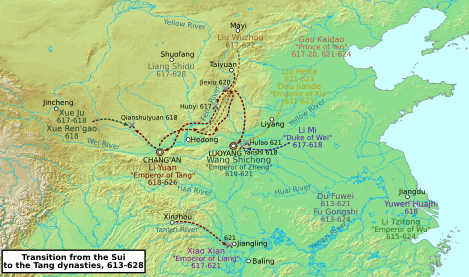 Transition from Sui to Tang (613–628)
Transition from Sui to Tang (613–628)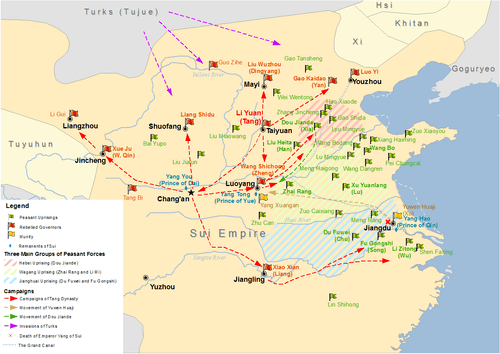 Transition from Sui to Tang (613–628)
Transition from Sui to Tang (613–628) Tang campaign against the Eastern Turks (629–630)
Tang campaign against the Eastern Turks (629–630)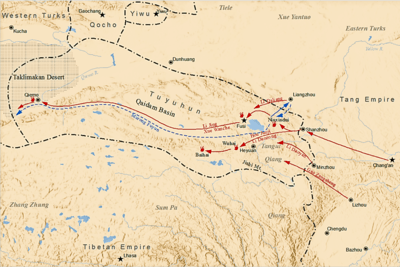

 Goguryeo–Tang War (645–668)
Goguryeo–Tang War (645–668)
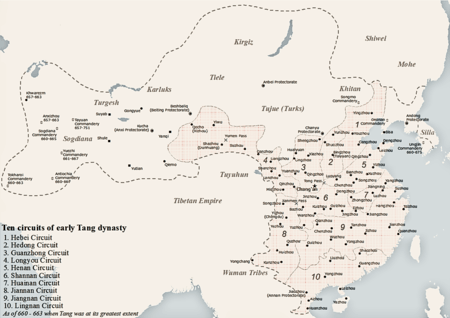 Tang dynasty in 660
Tang dynasty in 660 Battle of Dafei River in 670
Battle of Dafei River in 670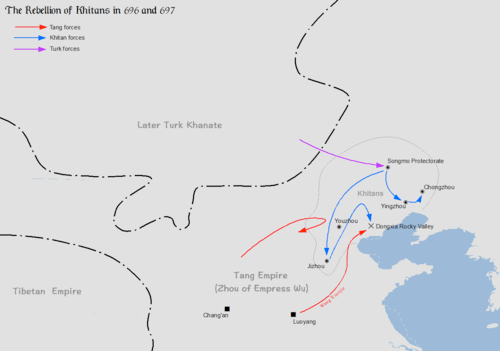 Rebellion of Li Jinzhong and Sun Wanrong in 696
Rebellion of Li Jinzhong and Sun Wanrong in 696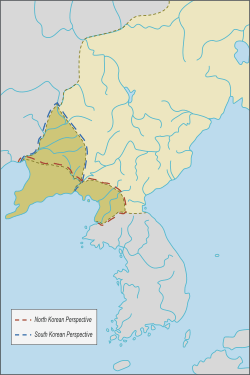 Little Goguryeo (699–820)
Little Goguryeo (699–820) Nanzhao (738–937)
Nanzhao (738–937)_(4261052261).jpg) Unified Silla and Balhae in the 8th century
Unified Silla and Balhae in the 8th century Major jiedushi in 745
Major jiedushi in 745 Battle of Talas in 751
Battle of Talas in 751 An Lushan Rebellion (755–763)
An Lushan Rebellion (755–763) Tibetan Empire in 790
Tibetan Empire in 790 Balhae in 800
Balhae in 800 Tang dynasty in 820
Tang dynasty in 820 Balhae in 830
Balhae in 830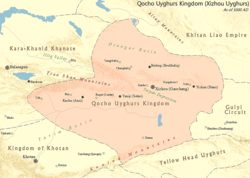 Qocho (843–1132)
Qocho (843–1132)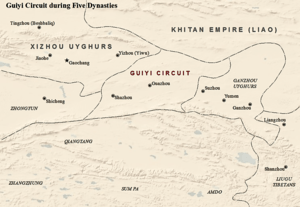 Guiyi Circuit (851–1036) and the Ganzhou Uyghur Kingdom (894–1036)
Guiyi Circuit (851–1036) and the Ganzhou Uyghur Kingdom (894–1036)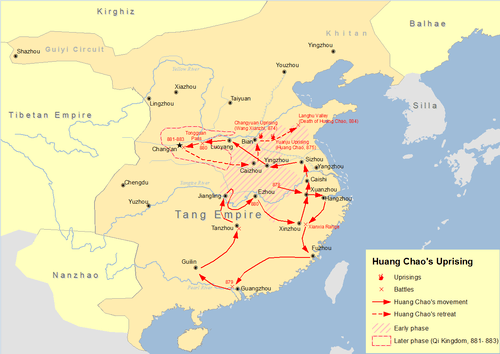 The uprisings of Wang Xianzhi and Huang Chao (874–884)
The uprisings of Wang Xianzhi and Huang Chao (874–884)
Citations
- ↑ Xiong 2008, p. 453.
- 1 2 3 4 5 6 7 8 9 10 11 12 13 14 15 16 17 18 19 20 21 Xiong 2009, p. cviii.
- ↑ Xiong 2009, p. 522.
- ↑ Xiong 2009, p. 132.
- ↑ Xiong 2009, p. 307.
- ↑ Skaff 2012, p. 303.
- ↑ Wang 2013, p. 246.
- ↑ Barfield 1989, p. 144.
- ↑ Latourette 1964, p. 144.
- ↑ Haywood 1998, p. 3.2.
- ↑ Xiong 2008, p. 579.
- 1 2 3 4 5 6 7 8 9 10 11 12 13 14 15 16 17 18 19 Xiong 2009, p. cix.
- ↑ Xiong 2009, p. 173.
- 1 2 Wang 2013, p. 40.
- ↑ Xiong 2009, p. 405.
- 1 2 3 Xiong 2009, p. 108.
- ↑ Beckwith 1987, p. 21.
- ↑ Wang 2013, p. 140.
- ↑ van Schaik 2011, p. 7.
- ↑ Beckwith 1987, p. 23.
- ↑ Ebrey, Walthall & Palais 2006, p. 91.
- ↑ Ebrey 1999, pp. 111, 141.
- 1 2 3 4 5 6 Xiong 2008, p. 45.
- ↑ Beckwith 1987, p. 24.
- 1 2 3 Bregel 2003, p. 16.
- ↑ Wang 2013, p. 45.
- ↑ Beckwith 1987, p. 25.
- ↑ Xu 2005, p. 240.
- 1 2 3 4 Wilkinson 2012, p. 910.
- ↑ Barrett 2008, p. 76.
- ↑ Xiong 2008, p. cix.
- ↑ Xiong 2008, p. 434.
- ↑ Czarnetzki, A.; Ehrhardt S. (1990). "Re-dating the Chinese amalgam-filling of teeth in Europe". International Journal of Anthropology. 5 (4): 325–332.
- 1 2 3 4 5 6 Bregel 2003, p. 17.
- ↑ Xu 2005, p. 239-40.
- 1 2 3 4 5 http://www.iranicaonline.org/articles/china-xv-the-last-sasanians-in-china
- 1 2 3 4 5 6 7 8 9 10 11 12 13 14 15 16 17 18 19 20 21 Xiong 2009, p. cx.
- ↑ Wang 2013, p. 146.
- ↑ Xiong 2000, p. 55.
- ↑ Graff 2002, p. 205.
- 1 2 Wang 2013, p. 81.
- 1 2 3 Graff 2002, p. 206.
- ↑ Wang 2013, p. 147.
- 1 2 3 Wang 2013, p. 148.
- 1 2 Wang 2013, p. 84.
- 1 2 3 4 5 Xiong 2008, p. 43.
- 1 2 3 Sima Guang, Zizhi Tongjian, Vol. 202
- 1 2 Barfield 1989, p. 149.
- ↑ Wang 2013, p. 149.
- ↑ Graff 2002, p. 207.
- 1 2 3 4 5 Skaff 2012, p. 308.
- ↑ Wang 2013, p. 149-150.
- ↑ Taylor 2013, p. 38.
- ↑ Wang 2013, p. 150.
- 1 2 3 4 5 Barfield 1989, p. 147.
- 1 2 Wang 2013, p. 151.
- 1 2 Skaff 2012, p. 309.
- 1 2 3 4 Wang 2013, p. 85.
- 1 2 Wang 2013, p. 87.
- 1 2 Beckwith 1987, p. 63.
- ↑ Beckwith 1987, p. 64.
- ↑ Wilkinson 2015, p. 326.
- 1 2 3 4 5 6 7 8 9 10 11 Xiong 2009, p. cxi.
- ↑ Skaff 2012, p. 311.
- 1 2 3 4 5 6 7 Bregel 2003, p. 18.
- ↑ Wang 2013, p. 155.
- ↑ Beckwith 1987, p. 76.
- ↑ Wang 2013, p. 88.
- 1 2 http://www.ancient-origins.net/ancient-places-asia/leshan-giant-buddha-largest-stone-buddha-world-003398
- ↑ Wang 2013, p. 156-7.
- ↑ Wang 2013, p. 157.
- ↑ Skaff 2012, p. 138.
- 1 2 Bregel 2003, p. 19.
- ↑ Wang 2013, p. 158.
- 1 2 3 Wang 2013, p. 220.
- 1 2 3 Wang 2013, p. 159.
- ↑ Beckwith 1987, p. 92.
- 1 2 Taylor 2013, p. 39.
- ↑ Beckwith 1987, p. 96.
- 1 2 Wang 2013, p. 160.
- ↑ Wang 2013, p. 161.
- ↑ Skaff 2012, p. 312.
- ↑ Wang 2013, p. 92.
- ↑ Skaff 2012, p. 45.
- ↑ Wang 2013, p. 164.
- ↑ Xu 2005, p. 248.
- ↑ Wang 2013, p. 103.
- ↑ Yuan 2001, p. 6723.
- 1 2 Wang 2013, p. 165.
- 1 2 3 4 Graff 2002, p. 213.
- ↑ Wang 2013, p. 165-6.
- 1 2 3 4 Wang 2013, p. 166.
- ↑ Beckwith 1987, p. 128.
- 1 2 3 4 5 6 7 8 9 10 11 12 13 14 15 16 17 18 19 20 Xiong 2009, p. cxii.
- ↑ Golden 1992, p. 141.
- ↑ Wang 2013, p. 309.
- 1 2 Graff 2002, p. 214.
- ↑ Xu 2005, p. 249.
- ↑ Partington 1960, p. 286.
- ↑ Graff 2002, p. 220-21.
- 1 2 Graff 2002, p. 221.
- ↑ Wang 2013, p. 167.
- ↑ Wang 2013, p. 49.
- 1 2 3 Karam 2012, p. 211.
- ↑ Graff 2002, p. 222.
- ↑ Xiong 2009, p. 249.
- ↑ Regina Krahl, "Green Wares of Southern China" in Shipwreck: Tang Treasures and Monsoon Winds, ed. by Regina Krahl, John Guy, J. Keith Wilson, and Julian Raby. Singapore: National Heritage Board, 2010, p. 186
- ↑ Graff 2002, p. 223.
- ↑ Wang 2013, p. 169.
- 1 2 3 4 5 Bregel 2003, p. 21.
- ↑ Sima 2015, p. 13639.
- 1 2 3 4 5 Beckwith 1987, p. 149.
- ↑ 嚴武, retrieved 12 February 2017
- 1 2 Barfield 1989, p. 154.
- 1 2 3 4 5 6 7 8 9 10 11 12 13 14 15 16 17 18 19 Xiong 2009, p. cxiii.
- 1 2 Beckwith 1987, p. 150.
- 1 2 Taylor 2013, p. 40.
- ↑ Beckwith 1987, p. 150-51.
- 1 2 Beckwith 1987, p. 151.
- ↑ Beckwith 1987, p. 152.
- 1 2 3 Wang 2013, p. 183.
- ↑ Wang 2013, p. 52.
- ↑ Wang 2013, p. 182.
- 1 2 Beckwith 1987, p. 154.
- ↑ Beckwith 1987, p. 157.
- ↑ Wang 2013, p. 184.
- 1 2 3 4 Taylor 2013, p. 41.
- 1 2 Xiong 2009, p. 280.
- ↑ Graff 2022, p. 237.
- ↑ Beckwith 1987, p. 163.
- 1 2 Lorge 2008, p. 32.
- ↑ Graff 2002, p. 237.
- ↑ Wang 2013, p. 185-6.
- ↑ Wang 2013, p. 187.
- ↑ Beckwith 1987, p. 166.
- ↑ Wang 2013, p. 53.
- ↑ Herman 2007, pp. 33, 35.
- ↑ Chaffee 2015, p. 544-545.
- ↑ Xiong 2009, p. 143.
- 1 2 3 4 5 6 7 8 9 10 11 12 13 14 15 16 17 18 19 Xiong 2009, p. cxiv.
- ↑ Drompp 2005, p. 114.
- 1 2 Wang 2013, p. 188.
- ↑ Rong 2013, p. 40.
- ↑ Taylor 2013, p. 42.
- ↑ Herman 2007, p. 36.
- ↑ Wang 2013, p. 189.
- 1 2 Herman 2007, p. 37.
- 1 2 3 4 5 6 7 8 9 10 11 12 13 14 15 16 17 18 19 20 21 22 Xiong 2009, p. cxv.
- ↑ Taylor 2013, p. 44.
- ↑ Chaffee 2015, p. 545.
- 1 2 3 4 5 Xiong 2009, p. cxvi.
- ↑ Andrade 2016, p. 31.
- ↑ Needham 1986, p. 85.
References
- Andrade, Tonio (2016), The Gunpowder Age: China, Military Innovation, and the Rise of the West in World History, Princeton University Press, ISBN 978-0-691-13597-7 .
- Asimov, M.S. (1998), History of civilizations of Central Asia Volume IV The age of achievement: A.D. 750 to the end of the fifteenth century Part One The historical, social and economic setting, UNESCO Publishing
- Barfield, Thomas (1989), The Perilous Frontier: Nomadic Empires and China, Basil Blackwell
- Barrett, Timothy Hugh (2008), The Woman Who Discovered Printing, Great Britain: Yale University Press, ISBN 978-0-300-12728-7 (alk. paper)
- Beckwith, Christopher I (1987), The Tibetan Empire in Central Asia: A History of the Struggle for Great Power among Tibetans, Turks, Arabs, and Chinese during the Early Middle Ages, Princeton University Press
- Bregel, Yuri (2003), An Historical Atlas of Central Asia, Brill
- Chaffee, John W. (2015), The Cambridge History of China Volume 5 Part Two, Cambridge University Press
- Chia, Lucille (2011), Knowledge and Text Production in an Age of Print: China, 900-1400, Brill
- Drompp, Michael Robert (2005), Tang China And The Collapse Of The Uighur Empire: A Documentary History, Brill
- Ebrey, Patricia Buckley (1999), The Cambridge Illustrated History of China, Cambridge: Cambridge University Press, ISBN 0-521-66991-X (paperback).
- Ebrey, Patricia Buckley; Walthall, Anne; Palais, James B. (2006), East Asia: A Cultural, Social, and Political History, Boston: Houghton Mifflin, ISBN 0-618-13384-4
- Golden, Peter B. (1992), An Introduction to the History of the Turkic Peoples: Ethnogenesis and State-Formation in Medieval and Early Modern Eurasia and the Middle East, OTTO HARRASSOWITZ · WIESBADEN
- Graff, David A. (2002), Medieval Chinese Warfare, 300-900, Warfare and History, London: Routledge, ISBN 0415239559
- Graff, David Andrew (2016), The Eurasian Way of War Military Practice in Seventh-Century China and Byzantium, Routledge, ISBN 978-0-415-46034-7 .
- Haywood, John (1998), Historical Atlas of the Medieval World, AD 600-1492, Barnes & Noble
- Herman, John E. (2007), Amid the Clouds and Mist China's Colonization of Guizhou, 1200–1700, Harvard University Asia Center, ISBN 978-0-674-02591-2
- Latourette, Kenneth Scott (1964), The Chinese, their history and culture, Volumes 1-2, Macmillan
- Lorge, Peter A. (2008), The Asian Military Revolution: from Gunpowder to the Bomb, Cambridge University Press, ISBN 978-0-521-60954-8
- Millward, James (2009), Eurasian Crossroads: A History of Xinjiang, Columbia University Press
- Needham, Joseph (1986), Science & Civilisation in China, V:7: The Gunpowder Epic, Cambridge University Press, ISBN 0-521-30358-3
- Rong, Xinjiang (2013), Eighteen Lectures on Dunhuang, Brill
- Shaban, M. A. (1979), The ʿAbbāsid Revolution, Cambridge: Cambridge University Press, ISBN 0-521-29534-3
- Sima, Guang (2015), Bóyángbǎn Zīzhìtōngjiàn 54 huánghòu shīzōng 柏楊版資治通鑑54皇后失蹤, Yuǎnliú chūbǎnshìyè gǔfèn yǒuxiàn gōngsī, ISBN 957-32-0876-8
- Skaff, Jonathan Karam (2012), Sui-Tang China and Its Turko-Mongol Neighbors: Culture, Power, and Connections, 580-800 (Oxford Studies in Early Empires), Oxford University Press
- Taylor, K.W. (2013), A History of the Vietnamese, Cambridge University Press
- Wang, Zhenping (2013), Tang China in Multi-Polar Asia: A History of Diplomacy and War, University of Hawaii Press
- Whiting, Marvin C (2002), Imperial Chinese Military History, Writers Club Press
- Wilkinson, Endymion (2012), Chinese History: A New Manual, Harvard University Asia Center for the Harvard-Yenching Institute
- Wilkinson, Endymion (2015). Chinese History: A New Manual, 4th edition. Cambridge, MA: Harvard University Asia Center distributed by Harvard University Press. ISBN 9780674088467.
- Yuan, Shu (2001), Bóyángbǎn Tōngjiàn jìshìběnmò 28 dìèrcìhuànguánshídài 柏楊版通鑑記事本末28第二次宦官時代, Yuǎnliú chūbǎnshìyè gǔfèn yǒuxiàn gōngsī, ISBN 957-32-4273-7
- Xiong, Victor Cunrui (2000), Sui-Tang Chang'an: A Study in the Urban History of Late Medieval China (Michigan Monographs in Chinese Studies), U OF M CENTER FOR CHINESE STUDIES, ISBN 0892641371
- Xiong, Victor Cunrui (2009), Historical Dictionary of Medieval China, United States of America: Scarecrow Press, Inc., ISBN 0810860538
- Xu, Elina-Qian (2005), HISTORICAL DEVELOPMENT OF THE PRE-DYNASTIC KHITAN, Institute for Asian and African Studies 7
- Xue, Zongzheng (1992), Turkic peoples, 中国社会科学出版社
This article is issued from
Wikipedia.
The text is licensed under Creative Commons - Attribution - Sharealike.
Additional terms may apply for the media files.